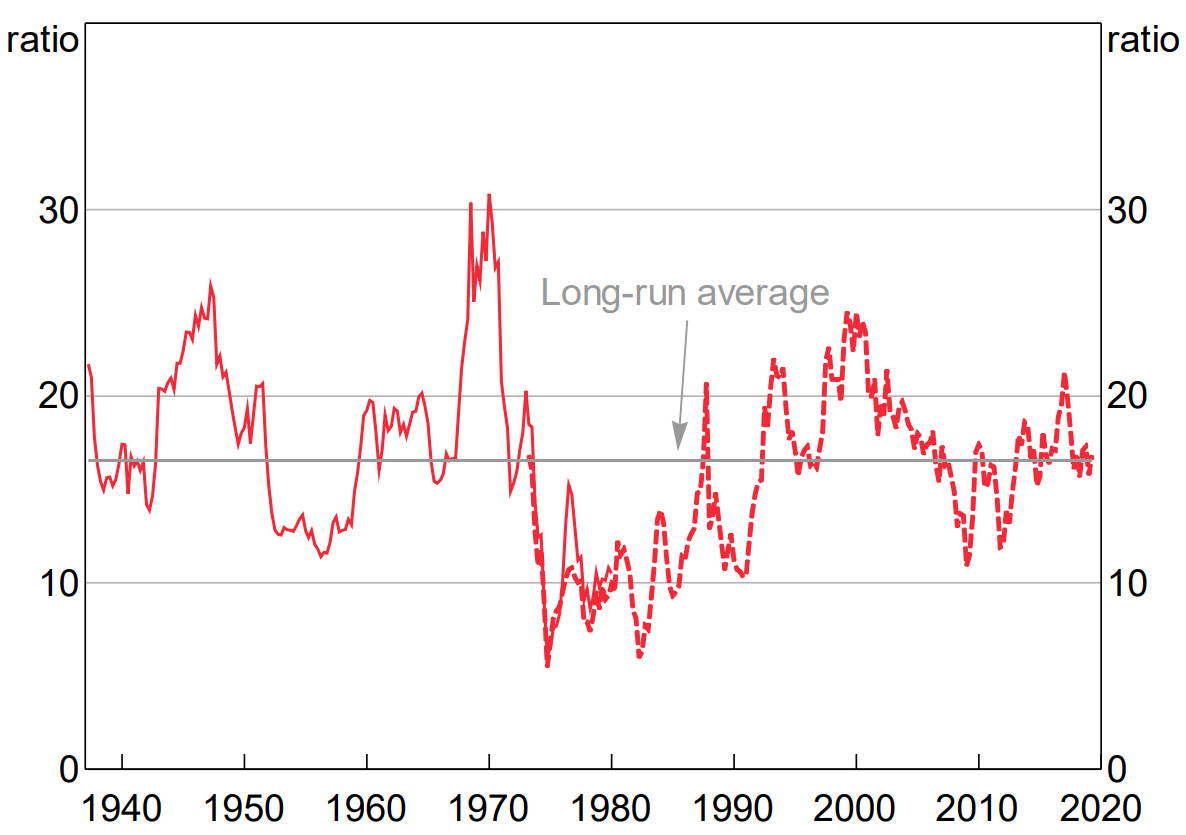ASX stocks just got more expensive, but not dangerous expensive yet
Value.
What is good value, what isn’t?
Many investors use the Price to Earnings Ratio (P/E Ratio) as a guide. You divide a company’s current stock price by its earnings, and the resultant ratio represents how many times the first covers the second.

Think of the P/E Ratio like this: If a company delivered the same earnings year in year out, it would take this many years to pay back my original investment in earnings. So, for example, if a stock is priced at $10 and it earned $1 last year, it has a P/E Ratio of 10 (or “10 times earnings”, or more commonly just “10 times”, or even just “10x”!).
This imaginary stock, which seems to be used in every P/E Ratio explanation ever created, has a payback period of 10 years. Obviously, a shorter payback period is better (because you want your investment back as soon as possible), and so a lower P/E Ratio is preferred to a higher one. Put simply, lower P/E Ratios typically equate to better value.
But there’s one big caveat: No company will ever deliver exactly the same earnings year in-year out. So, to really extract the true benefits and power of the P/E Ratio, one really should forecast a company’s earnings for at least the coming year. You might hear this referred to as a “forecast P/E” or a “1-year P/E”, or a “forward P/E”.
Forward P/E Ratios are more useful indicators of company values than those based upon historical data, but to be fair, they’re only as good as the investor doing the forecasting. For those who wish to play along at home, I suggest there’s some (as in, not zero!) value in using historical P/E Ratios to compare company valuations, but you really want to get your hands on good, reliable forecast P/E Ratios.
This is where this article comes in! Major broker Macquarie has issued its first Market Ratios research report for 2024. This fortnightly series assesses the P/E Ratios for a few of the major ASX sectors as well as the Australian stock market as a whole. Most importantly, Macquarie only publishes forward P/E Ratios based upon its earnings estimates for Australian companies – so rest assured we’re only dealing in forward P/E Ratios here.
History doesn’t repeat, but it sure does rhyme
Before we get to Macquarie’s data, let’s investigate what a “normal” P/E Ratio looks like for the Australian stock market.

There’s a long-held rule of thumb for the P/E Ratio for any stock market – 15 is considered “fair value”, that is where stocks are neither cheap nor expensive by historical measures, 10 is usually considered “cheap”, and 20 is usually considered “expensive”.
This old rule of thumb holds up reasonably well against the data for the Australian stock market. In the 20-year period prior to the COVID-19 pandemic, the average PE Ratio for the benchmark S&P/ASX 200 was 15.7. It bottomed just below 10 in March 2023 at the depths of the pandemic correction, and it topped out around 20 at the most recent record high set in August 2021.
Go back to most cycles prior, and you will see a similar pattern: major market lows tend to coincide with market P/E ratios around 10, and major market corrections tend to follow periods where the market P/E ratio had traded at 20 or above. For example, the P/E ratio of the ASX 100 peaked just below 23 just before the 1987 stock market crash and bottomed just below 10 in 1990. It was a similar experience before and after the GFC in the late 2000’s.

Stocks got more expensive last month
To get an idea of whether the Australian stock market is currently cheap or expensive, we can look at Macquarie’s forward P/E estimates for the S&P/ASX 100. The ASX 100 contains the hundred largest ASX listed companies which together account for approximately 3/4 of the total market capitalisation of the Australian stock market.
Macquarie suggests the ASX 100’s FY24 P/E Ratio increased to 17.1x from 16.3x as at its last update on 19 December. This is well above the long term average of 15.7x, but still well below danger levels above 20x. As earnings are expected to grow in FY25 and FY26, those years’ PE Ratios are lower at 16.3x and 15.9x, but these are also markedly higher than their December readings of 15.3 and 14.6 respectively.

P/E Ratios rise when price increases at a faster rate than earnings estimates, or when earnings estimates fall at a faster rate than price. Neither scenario is very good, and the above data suggests the first scenario has occurred – prices have risen since December faster than forecast earnings. Aussie stocks have generally become more expensive.
At a FY24 P/E Ratio of 17.5, stocks outside the ASX100 are trading at a higher P/E Ratios than those within it. This makes sense when you consider these are smaller companies which typically won’t have as reliable earnings than those in the top one-hundred, or maybe higher growth and therefore typically have higher P/E Ratios.
Financial stocks FY24 P/E Ratio of 15.1x (up from 14.3 in December) appears to be fair value using regular 10-15-20 metrics, but this would be faulty thinking! We should compare markets / sectors on a like-for-like basis. The long run P/E Ratio for Financials is 13.3, so this would suggest these companies are presently as much as 13.5% overvalued (up from 7.5% overvalued in December).
Resources stocks look far cheaper than their Financials counterparts at a FY24 P/E Ratio of 14.1x (up from 13.5x in December). The good news for investors in resources stocks, is this is still roughly in-line with the long term average P/E Ratio for the Resources sector of 14.0. So, resources companies currently represent fair value.
The bad news for resources investors is Macquarie’s FY25 and FY26 P/E Ratios for the sector have risen to 12.9 and 13.8 compared to 12.1 and 12.0 in December’s update. This disproportionate increase compared to FY24 numbers suggests to me that Macquarie has lowered its earnings forecasts for the sector in future years.
Finally, Real Estate stocks appear the most expensive of the three sectors Macquarie covers, with a P/E Ratio of 17.2. This is lower than December’s 17.3, however, indicating Real Estate stocks have edged a little cheaper over the past month, but they remain roughly 5.5% more expensive than the long term average for the sector.
Valuations are high, but not ringing the bell just yet!
Macquarie’s latest Market Ratios report shows Aussie stocks have generally become more expensive over the past month. This is most likely to do with price rises in some sectors like Financials and Real Estate not keeping up with earnings, and earnings being downgraded faster than prices have generally fallen in Resources.
Regardless, the market P/E Ratio of 17.1x remains a reassuring 17.5% below the August 2021 peak of 20.1. Using the same logic, the P/E Ratio for Financials of 15.1x remains 9.2% below its August 2021 peak of 16.5x, Resources at 14.1x remains a tidy 12.7% below its August 2021 peak of 15.9x, and Real Estate at 17.1x remains a comfortable 15.7% below its August 2021 peak of 19.8x.
The bottom line: I’m not ringing the bell on valuations yet!
This article first appeared on Market Index on 24 January 2024.
4 topics

